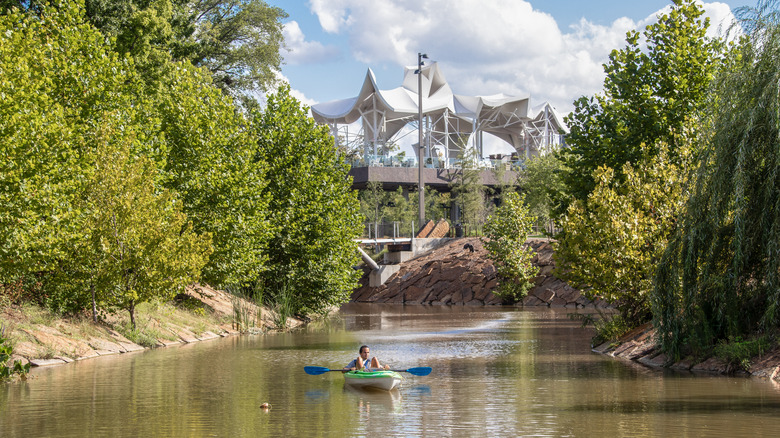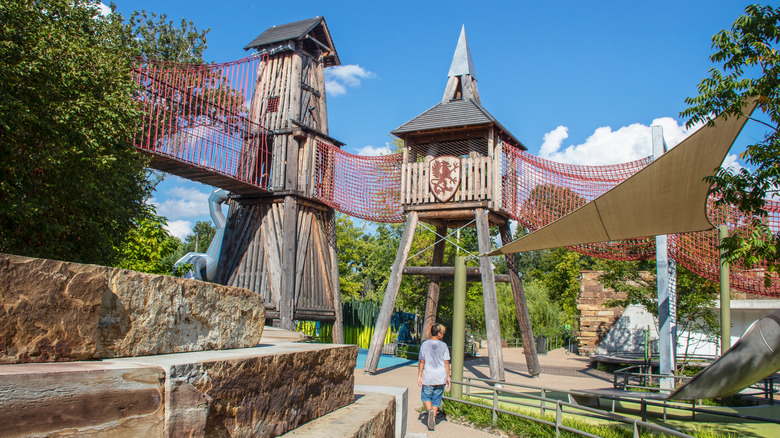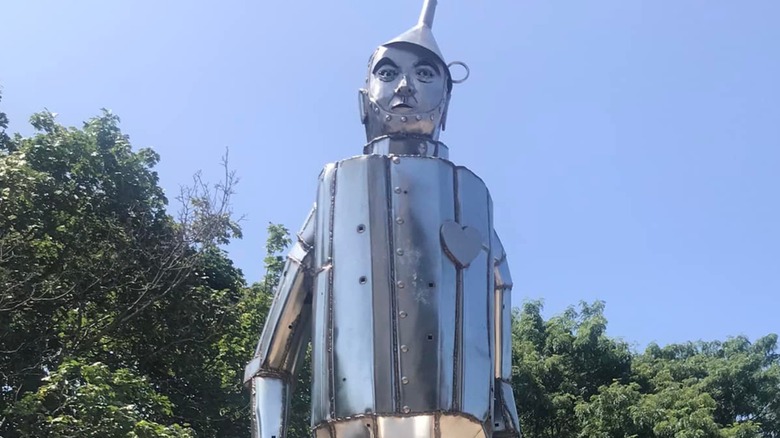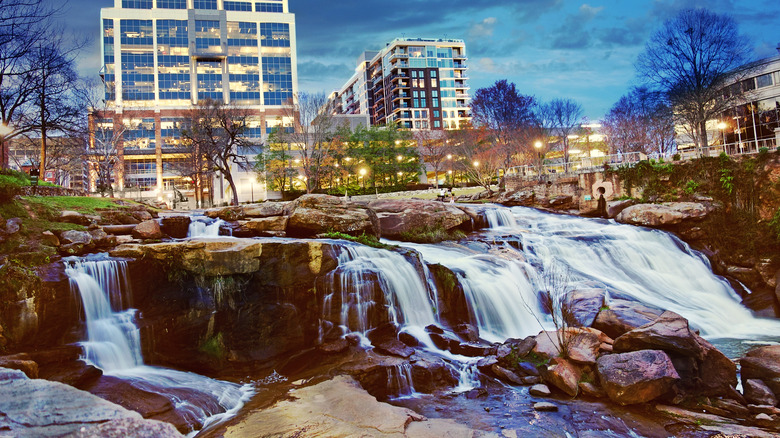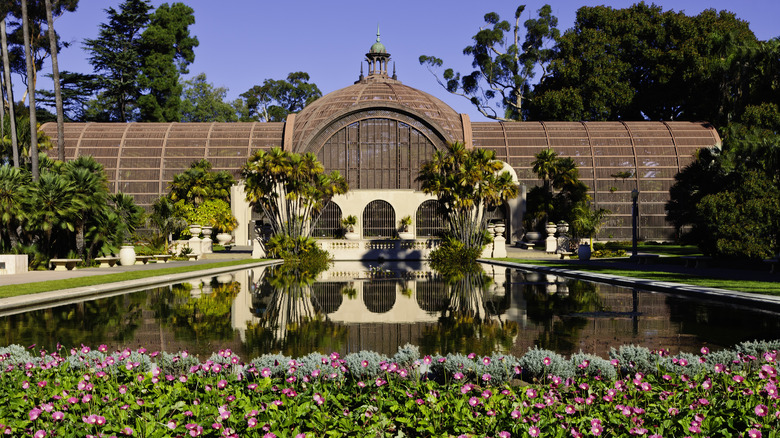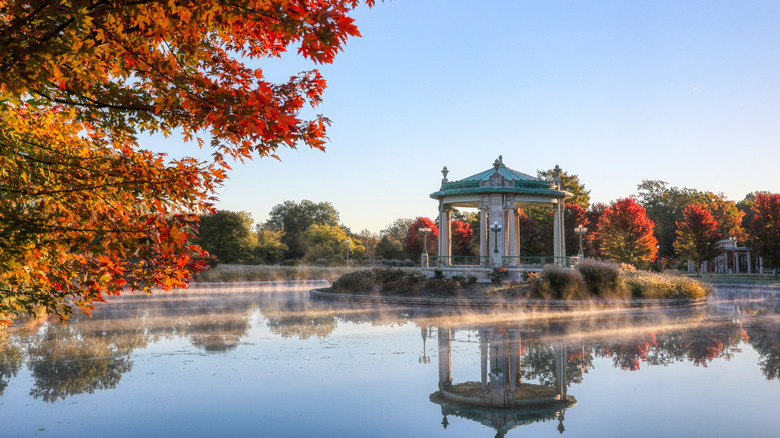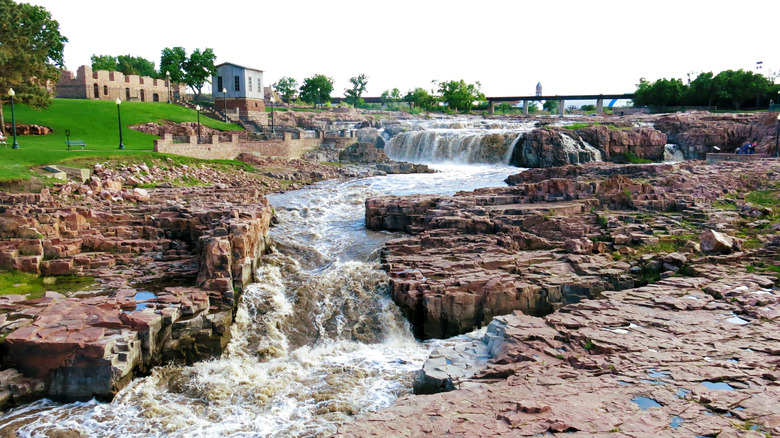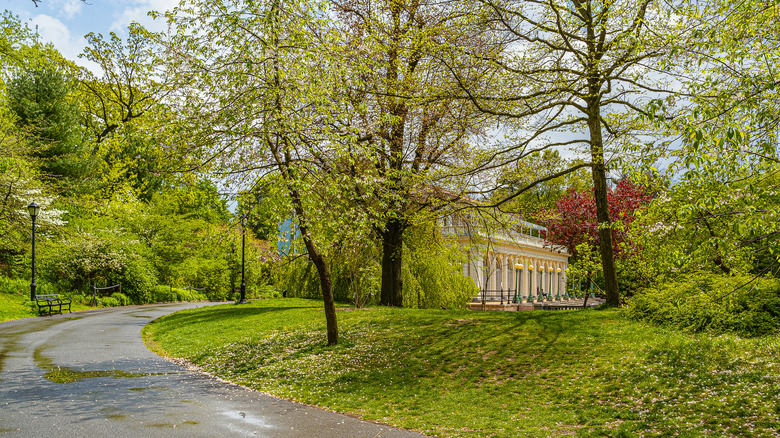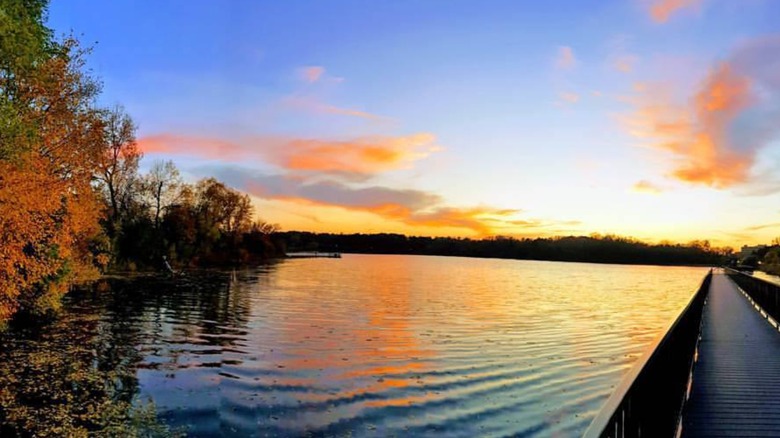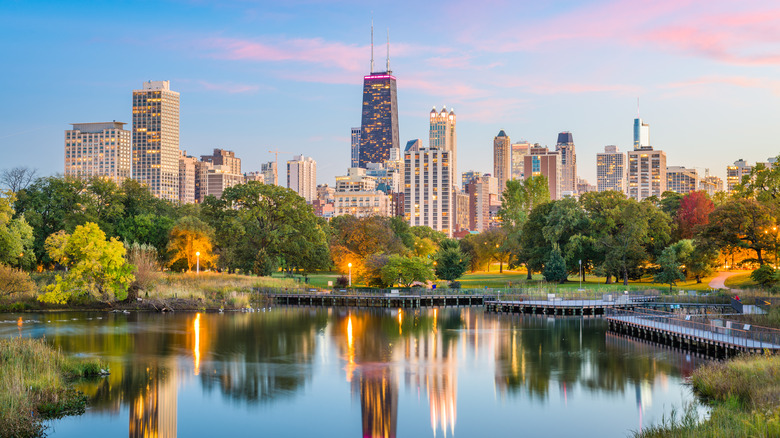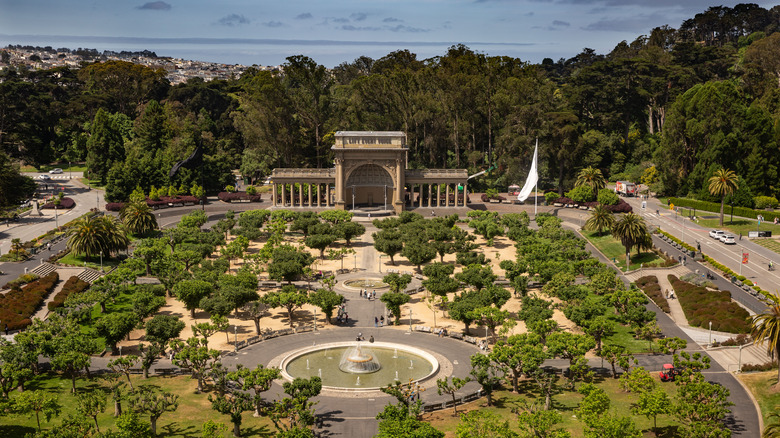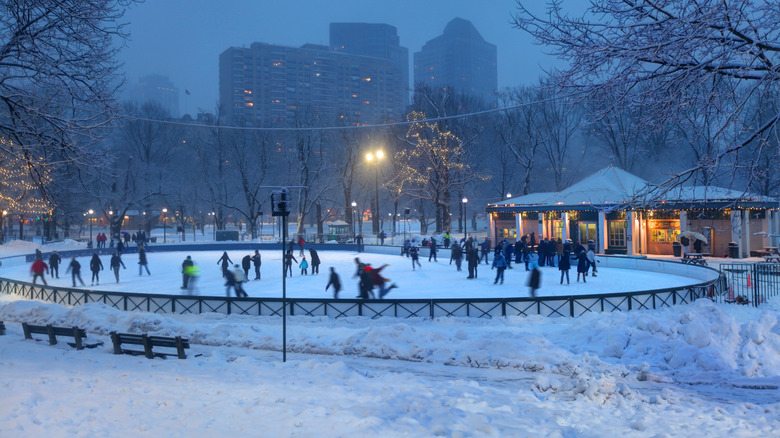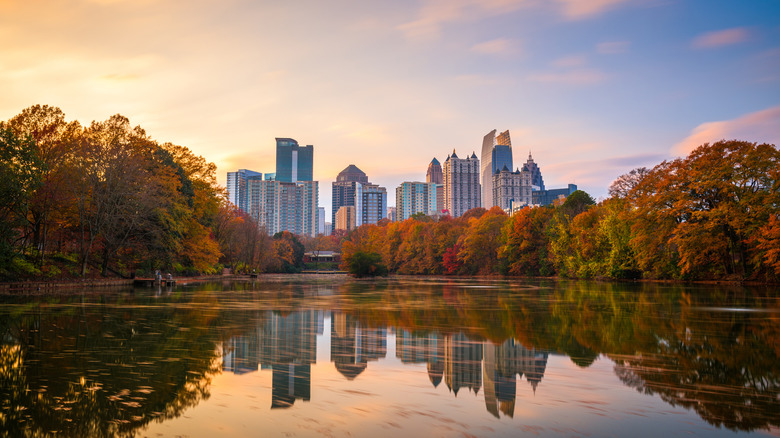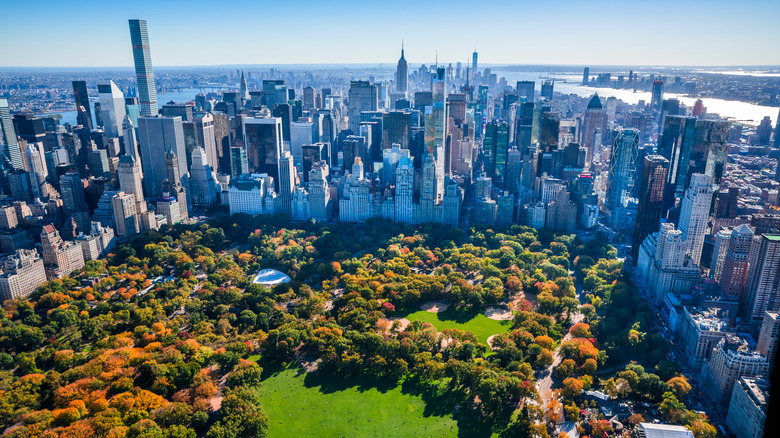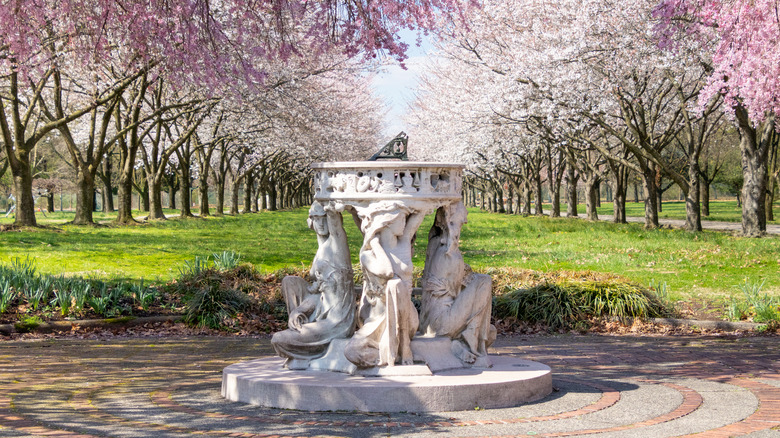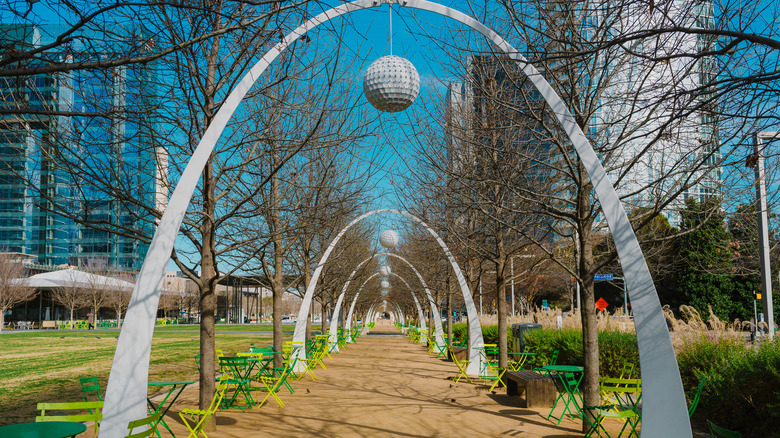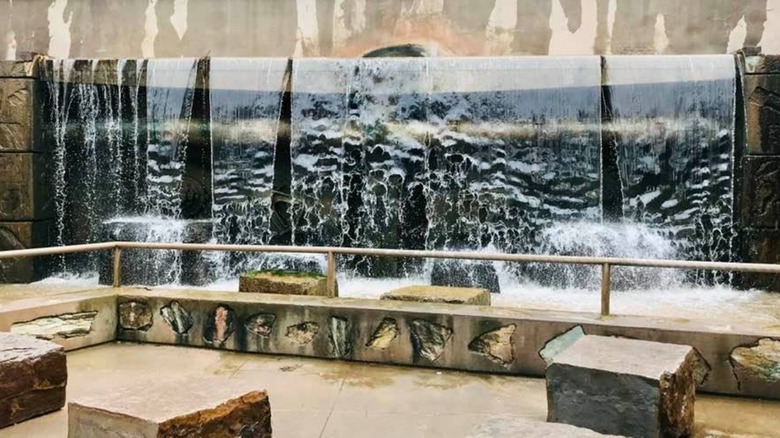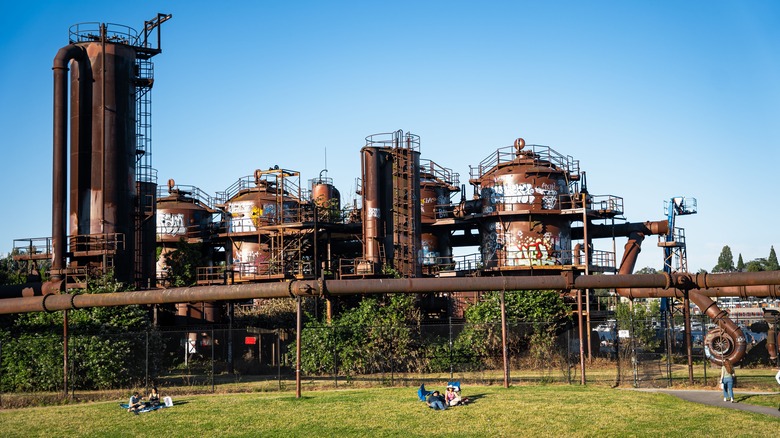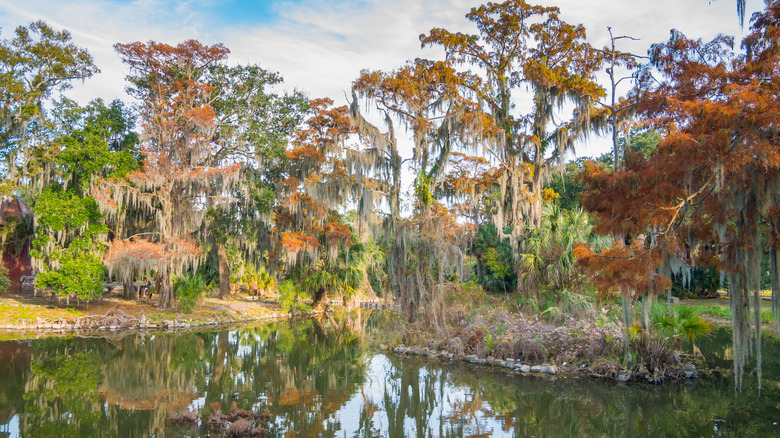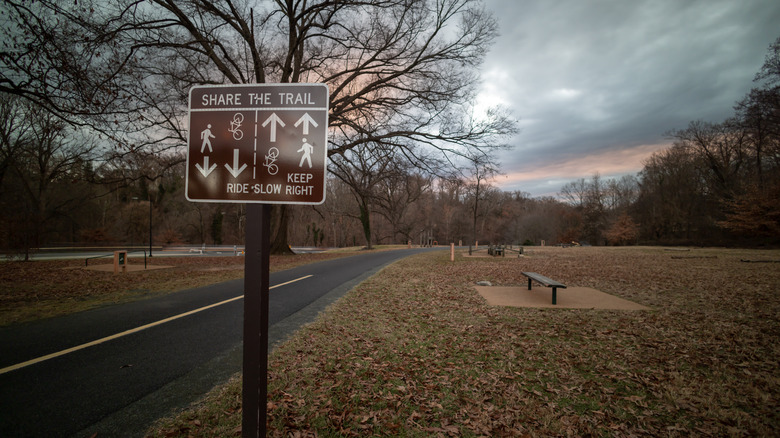The Coolest Public Parks You Can Find In The US
Thanks in part to our increasingly digital economy and fundamental changes in how we communicate, most folks spend far too much time in front of a screen. But one of the best things we can do to recharge our minds and bodies is to get out into the sunshine and breathe fresh air.
Whether jamming to a free outdoor concert or knocking out 18 holes of disc golf, spending time in the park is never a bad idea. As the connection between healthy lives and healthy cities becomes increasingly more apparent, many cities are thinking outside the box to create interactive outdoor green spaces that bring folks together while encouraging healthy habits. From parks built over highways to repurposed industrial equipment, we're taking a look at some of the coolest public parks to hang out at in the United States. But don't enjoy these outdoor spaces alone; our selections are best experienced with loved ones.
The Gathering Place in Tulsa, OK
One of about 236 wealthy signatories to take The Giving Pledge, BOK chairman George Kaiser has spent much of his life giving back to his community of Tulsa, Oklahoma. In 2014, his foundation donated a sprawling $465 million park along Tulsa's Riverside Drive — the largest private gift to a park in United States history. Completed in 2018, the nearly 70-acre Gathering Place has lived up to its name as a popular year-round hangout for Tulsans, earning a place on many national top park lists, including being the No. 1 U.S park among USA Today readers in 2021.
The park's imagination-inspiring landscape features a wealth of creative play spaces, including accessible play equipment for mobility-impaired guests and low-level play areas designed for toddlers to crawl around safely. Bigger kids can dream away on the park's iconic climbing towers and bridges or slide down Slide Vale's thrilling slides. The park also features a water play space for younger guests to splash around in, a boat house that offers kayak, canoe, and paddleboat rentals, an outdoor concert stage, a multi-skill level skate park and BMX track, and a hands-on children's museum called the Discovery Lab.
The park hosts free cultural events and live music. Kids who visit can check out a free activity backpack filled with a range of educational activities, and guests are also invited to try out one of the park's several self-guided activities, like scavenger hunts, birdwatching, or a horticulture tour of the park.
Oz Park in Chicago
While it isn't one of the nation's more elaborate parks, Oz Park in Chicago, with its Wizard of Oz theme, is one of the coolest, most charming public parks in the country. Named after famous Chicago resident Frank L. Baum, who wrote the beloved children's book series, Oz Park is a must-see for anyone who loved Dorothy's adventures on the yellow brick road.
The grounds feature an inviting garden that's appropriately dubbed Emerald City Gardens. Scattered around the park, you'll find statues of Dorothy and her friends, the Cowardly Lion, Tin Man, and Scarecrow hanging around. Oz Park also houses Dorothy's Playground, a play area for its younger guests. Besides the whimsical theme, park visitors can take advantage of its courts — tennis, basketball, volleyball, or the athletic field. The park also consists of a community garden and offers regular summer programming, including a day camp for children.
Falls Park on the Reedy in Greenville, SC
Located in the historic West End near downtown Greenville, South Carolina, Falls Park is a living example of the movement to create green spaces in over-industrialized areas. Built on reclaimed land that once housed the city's textile mills, Falls Park has become a favorite spot to breathe fresh air in the city. One of the park's highlights is its Liberty Bridge. This iconic curved suspension bridge takes pedestrians 355 feet across the Reedy River, providing stunning views of the falls and several scenic overlooks to make one appreciate the world around them.
Upon entering the park through the peaceful two-acre Pedrick's Garden, guests are treated to a variety of commissioned art that includes the cheery Sunflower Fountain and famed glass sculpture artist Dale Chihuly's enchanted Rose Crystal Tower, a ruby-hued installation that's evocative of rock candy. The park's plentiful stonework, calming waterfalls, sumptuous gardens, and winding trails serve as an ideal backdrop for adventure. Falls Park also has two amphitheaters and each summer, it plays host to the Upstate Shakespeare Festival, a free public event intended to make Shakespeare's plays accessible to the general public.
Balboa Park in San Diego
At an expansive 1,200 acres, San Diego's Balboa Park is more of a thriving cultural center than a park. The grounds are home to a wide range of museums, including the Comic-Con Museum, Centro Cultural de la Raza, and San Diego Art Institute, and the park even offers a museum explorers' pass that grants holders access to most of them. Here, you'll find just about every type of recreation imaginable — golf, disc golf, lawn bowling, and even a velodrome for track cycling. And there's even a rec center if badminton or table tennis is more your speed.
The park is also home to seemingly endless trails and gardens. At Zoro Garden, a sunken grotto that once housed a nudist colony has been transformed into a butterfly garden. There's a veterans memorial, an educational garden designed to teach visitors about medicinal plants, a rose garden, a cactus garden, an Australian plant garden, and even a lily pond.
Forest Park in St. Louis
Like Balboa Park in San Diego, St. Louis' Forest Park is a sprawling complex of museums and gardens. The park is a favorite for birdwatchers, hosting regular birding walks throughout the year in coordination with the St. Louis Audubon Society. Nature lovers can also check out the park's self-guided audio tours. To get kids active and connected to the outdoors, the park features a 17-acre nature playscape with nine activity areas, including water pumps, stump steppers, willow tunnels, and sand play areas. Families can also gather in the nature center to enjoy storytime throughout the summer months thanks to a partnership with the local library system.
One of the highlights of the park is the Saint Louis Zoo, which is completely free to visit. The park is also home to the Missouri History Museum, the Saint Louis Science Center, and the Saint Louis Art Museum, where visitors can enjoy more than 30,000 pieces of art spanning the globe and thousands of years of human history.
Falls Park in Sioux Falls, SD
Named after the waterfalls ornamenting the Big Sioux River as it runs through Sioux Falls, Falls Park features some of the most fascinating natural geographies of any urban park in the country. Situated in the heart of the city, the 123-acre park is one of the city's most popular gathering places. Every Saturday from May through October, Sioux Falls residents gather to participate in the Falls Park Farmer's Market.
During the holiday season, the park is transformed into a dazzling Winter Wonderland, featuring more than 23 miles of light strings, dozens of wreaths, and hundreds of decorated holiday trees. The visitor center is housed in a five-story viewing tower where park guests can step onto the observation deck and enjoy a panoramic view of the city skyline and waterfalls. The abandoned Queen Bee Mill is situated on the grounds, a historic building complex that serves as a reminder of the town's heritage. The park is also home to the Stockyards Ag Experience Plaza and Barn, a free educational museum highlighting the city's agricultural industry.
Prospect Park in NYC
Brooklyn's Prospect Park is a 585-acre urban green space designed by the landscape architects who developed Central Park. Situated adjacent to several of Brooklyn's historic, tree-lined residential neighborhoods, the park is a popular urban retreat for locals. One of the park's more popular attractions is the 3.36-mile loop known as Park Drive, where pedestrians, cyclists, and skaters can experience the glory of autumn in New England. With its numerous picnic areas and seven dynamic playgrounds, the park is a perfect place for families to spend the day catching some Vitamin D; animal lovers can also check out the Prospect Park Zoo.
The Zucker Natural Exploration Area offers a magical experience that feels like something out of a storybook. Created from recycled natural materials, this natural play area gives kids a space to reach into their imaginations and follow their curiosity as they climb over, under, and through a safe, natural environment that feels about as close to a forest adventure as most city kids will get to experience. The park also features a dreamy hand-carved 1912 carousel and an Audubon center.
Theodore Wirth Regional Park in Minneapolis
Managed jointly by Minneapolis and its neighboring suburb Golden Valley, Theodore Wirth Park is the largest park within the Minneapolis park system. It is one of the few U.S. parks that's even more fun in the winter than in the summer months. The park features an interconnected system of groomed trails winding up and down hills, through the forest, and along Minnesota's scenic lakes. The 14-mile trail system offers multi-functional courses for all difficulty levels that can be walked, biked, or skated during the warm weather months. Once the landscape is blanketed with snow, these trails double as ski trails. Guests can also use the park for snow tubing, sledding, and snowboarding.
After the snow melts, guests can stop by the park's wildflower garden and bird sanctuary, which features 130 bird species, including warblers and woodpeckers. Guests with a mind for birdwatching can even pick up a seasonal birding guide from the park's website. The park also offers an 18-hole disc golf course, a fishing pier, and an archery range.
Lincoln Park in Chicago
Situated along Lake Michigan in Chicago, the 1,208-acre Lincoln Park is the largest in the city. No matter what sport you're into, Lincoln Park has you covered — the park's extensive range of recreational offerings includes basketball courts, volleyball courts and beach volleyball, lacrosse fields, tennis courts, an archery range, a driving range, a skate park, and cricket and rugby pitches. The park's older section is a popular destination for ghost hunters for a good reason. Part of the park dates back to 1843 when it served as the city cemetery. Although the cemetery was eventually moved, legend has it that not all of the bodies did.
The park is blessed with a diverse geography that includes 7 miles of shoreline. During the summer months, park guests are welcome to swim or sunbathe on the park's seven public beaches. Lincoln Park is also home to three harbors with dock facilities, moorings, a fueling dock, and a public launch. To encourage locals to commute by bike, the park features an 18-mile multi-use lakefront trail running from north to south. The park also features two museums and a zoo.
Golden Gate Park in San Francisco
Inspired by Central Park as San Francisco began to take off in the 1860s, locals decided they needed a big city park system to while away the hours. Although it's hard to believe looking at today's lush green space, the park grounds started as a sandy and rather inhospitable windswept shore dune region called the Outside Lands, lying outside the city borders.
Today, Golden Gate Park's 680 acres of forest boast up to 130,000 trees, and the park is home to several commemorative tree groves, including the Phil Arnold Oak Woodlands Trail, Redwood Memorial Grove, Heroes Grove, and the National AIDS Memorial Grove. The park's many charming gardens include a Victorian flower conservatory, a Shakespeare garden, a Japanese tea garden, the San Francisco Botanical Garden at Strybing Arboretum, and a Dutch tulip garden. There's also a community garden and an additional one for roses, dahlias, camellias, fuschia, and rhododendrons.
Guests can also check out the park's bison paddock or stop by one of the park's museums. Besides offering staples like disc golf, baseball, tennis, and jogging trails, the park also features a skate park, a dedicated roller skating area, archery, an anglers' lodge, handball and racquetball courts, and a polo field.
Boston Common in Boston
The United States' oldest park, Boston Common, has been used continuously by the public for various reasons, from cow herding to public speaking venues since the 1630s. The grounds had seen many historical events, including the Boston Bread Riot of 1713 and the American Revolutionary War when it served as a British military encampment. The park was officially made into a public park in the 1830s.
Today, the park features a variety of pastimes to keep Bostonians busy. Younger guests can enjoy the vintage Boston Common Frog Pond Carousel or climb around on the whimsical Frog Pond playground. The Boston Frog Pond is a splash pad during the summer months and an ice skating rink during winter. The whimsical Boston Ducklings sculptures are also a popular site for families to check out. A stroll around the park is a delight for history buffs. Among the Common's many historical sites, visitors will find the Boston Common Tablet, the 1868 Brewer Fountain statue, several monuments to soldiers, and the Parkman Plaza statues.
Piedmont Park in Atlanta
A 200-acre urban park managed by the Piedmont Park Conservancy, Atlanta's Piedmont Park aims to get Atlantans away from their screens and into the outdoors. The park hosts a number of community and music festivals each year, including Atlanta Pride, Atlanta Black Pride, Music Midtown, and the Atlanta Jazz Festival, just to name a few. The park also features a host of exciting programming — canning workshops, swim-in movies, and trivia nights are just some of the offerings.
Locals can beat the southern heat in Piedmont Park's dazzling aquatic center and pool, which features four lap lanes, pool-level locker rooms, and beach entry with a current channel for floating. The park also offers a weekend farmer's market, a community garden, dog parks, and fishing. Piedmont is also home to the only U.S. playground designed by American artist and landscape architect Isamu Noguchi, known for his work in biomorphism.
Central Park in NYC
Central Park has served as an example of a well-executed city green space for more than a century, with cities across the country taking inspiration from the park. Despite being surrounded by the New York skyline, the carefully planned park's 36 acres of woodland paths and winding, tree-lined trails offer an escape from the concrete jungle. Despite its long history as an urban oasis, by the middle of the 20th century, Manhattan's massive city park had picked up a rather unsavory reputation as a place to get mugged. But thanks to the city's efforts and an overall decrease in crime, the park has primarily reformed its reputation and seems no more or less safe than any other big city park.
One of Central Park's more iconic locales is the recently restored Chess & Checkers House, where New Yorkers from all ages and walks of life can come together to play games. The park's historic Swedish Cottage operates as a marionette theater. In addition to housing the Metropolitan Museum of Art and Central Park Zoo, the park also features a children's zoo and carousel.
Fairmount Park in Philadelphia
Comfortably sandwiched around Philadelphia's Schuylkill River are the East and West sides of Fairmount Park, the city's massive municipal park system. The bucolic park's green hills and plentiful water features look like something pulled from an oil painting. The park is home to a seemingly endless number of historical sites and attractions. On the west side, you'll find the Shofuso Japanese House & Garden, the lilypad-covered Concourse Lake, Centennial Arboretum, Smith Memorial Arch, and Belmont Pumping Station. Travel down a 60-foot walkway to find yourself standing in the Pavilion in the Trees, an observation platform looming over a natural basin.
Cross to the east side, and you'll find the historic Strawberry and Laurel Hill Mansions, Fairmount Water Works, Mount Pleasant, and the East Park Canoe House and Reservoir. Both sides of the park are family-friendly, offering a number of children's play spaces and hands-on activities. The park also features a recreation center with sports, a pool, and an arts and crafts room.
Klyde Warren Park in Dallas
Realizing Dallas was woefully short on green space, Klyde Warren Park's creators set out to make something out of nothing — and they did just that. The solution was to build what's known as a "deck park," a type of green space that's created by building a deck over a high-traffic area. Not only do deck parks create city parks where there is none, but they also serve to reconnect communities divided by busy thoroughfares.
One of the first of what could be an answer to one of modern city life's most pressing problems, Klyde Warren is a 5.2-acre park that features a scenic walkway, dog park, performance pavilion, food truck lanes, verandas, and an interactive fountain with a choreographed water and light show that changes each month. Park guests can check out a book or game at the lending library or visit the esplanade to play ping-pong, foosball, or French bocci ball (petanque). The East Lawn features a putting green, and the children's area offers a child-sized amphitheater, storytelling tree, and playgrounds.
Arizona Falls Park in Phoenix
As America's hottest city, Phoenix, Arizona, can be almost unbearable during the miserable summer months. But thanks to the natural drop in the manmade Arizona Canal that created Arizona Falls, Phoenix folks have been cooling off there since its creation. When the small WaterWorks hydroelectric plant was restored in 2003, the state organization overseeing the project partnered with the Phoenix City Council to transform the space into a public park at the same time. A sculptor, architect, and land architect were brought on board to incorporate the park's industrial elements into its overall charm, and the park transformation was in full swing.
Pedestrian walkways, seating, decorative walls, landscaping, and a footbridge across the canal were added, as was signage detailing the plant's design and history. On display are five boulders, one representing each of the Salt River's major dam sites. While there, guests can learn about the hydroelectric plant, which provides power for around 150 homes. The small park also offers a wheelchair-accessible route.
Gas Works Park in Seattle
Like Arizona Falls, Seattle's Gas Works Park is an urban park that seamlessly integrates features from the public works system. The 19.1-acre park is built on the grounds where a Seattle Gas Light Company plant once stood. What's left is the remains of the only coal gasification plant still around today; it was added to the National Register of Historic Places in 2013.
The plant transferred to the city's ownership in 1962 when it was purchased as a public park, with many parts of the facility adapted and repurposed as part of the transition. For example, the old exhauster-compressor building was upcycled into a children's play structure, the boiler house is now a picnic facility and many of the plant's parts are stand-alone urban art pieces.
Due to hazardous materials related to the plant, park guests can't go into the water, but there's still plenty to do. Gas Works regularly hosts community events like yoga and live music shows. The park also features a "Great Mound" built on top of industrial rubble meant to serve as a kite-flying hill — equally suitable for frisbee games and afternoon picnics. Climb to the top, and you'll find a dazzling sundial created by a pair of local artists.
City Park in New Orleans
Everything New Orleans does is fabulous, so it stands to reason the Big Easy would be home to one of the country's coolest parks. The story of the 1,300-acre City Park dates back to 1854. The park got a boon with the 1930s Works Progress Administration (WPA), Roosevelt's infrastructure injection meant to stimulate the economy out of the Great Depression. After much of the beloved park was wiped out after weeks spent under floodwater in the wake of Hurricane Katrina, the public rebuilding effort provided enough to rebuild and add improvements.
The park owes much of its beauty to its collection of centuries-old oaks, some of which have been alive for around 800 years. One of City Park's most remarkable features is its 60-acre Couturie Forest, which features eight distinct ecosystems and is home to dazzling waterways and a haven for birders. The park is also home to a mini golf complex, a children's museum, a musical art installation called the Singing Oak, a full-service golf complex, and a two-acre sustainable community farm.
But to four-legged friends, the park's finest attraction is NOLA City Bark, a brilliant dog park equipped with shade pavilions, water fountains, a water play area, doggie pools, and separate play areas for small and large dogs.
Rock Creek Park in D.C.
Part of the national park system, thanks to its federal location, Rock Creek Park is a vast city park of 1,754 acres located in the northwest corner of D.C. It's a popular spot for birding, and much native flora and fauna call the parklands home, including red and gray foxes, coyotes, southern flying squirrels, beavers, chipmunks, shrews, and white-tailed deer. Several civil war sites, including Fort Slocum, Fort DeRussy, and Fort Bunker Hill, can be found on the grounds. The park's historic features also include colonial buildings, a number of old mills and bridges, and a handful of statues.
Rock Creek Park's Cascading Fountain is a 13-basin fountain that feels like it's been swiped from a grand European estate. A tributary of the Potomac, Rock Creek's shallow waters is perfect for paddling. Stroll through the wild and wonderful naturalistic gardens of Dumbarton Oaks, spend an afternoon hiking the park's 32 miles of trails, or step into the fairy tale columns of Francis Scott Key Park.
